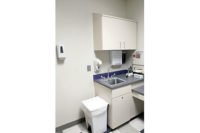
As companies are becoming more environmentally conscious, they are finding more ways to become “green.” Toilets have gone low-flow, and faucets now have maximum flow rates. Manufacturers continue to find new ways to reduce and reuse our precious natural resources.
Waterless urinals are a relatively recent addition to the building code. Incinerating toilets that combust toilet waste rather than adding to the waste water system are another innovative product that has become available.
The U.S. Environmental Protection Agency (EPA) launched the WaterSense® program in 2007 and has established criteria for products such as lavatory faucets, toilets, and, soon, for irrigation products. Only about 1% of the Earth’s water is available for drinking, according to the EPA. This makes the conservation of water very important.
High-efficiency toilets (HETs) perform with a reduced amount of water. The average person will flush a toilet 140,000 times in his lifetime, and toilets account for 30% of the total household water usage, according to the EPA. Toilets certified by the WaterSense program are required to use less than 1.28 gallons per flush. This would result in an annual savings of 4,000 gallons of water per residence.

In order to ensure adequate performance at lower pressures, lavatory faucets also need to have a minimum flow rate of 0.8 gpm at 20 psi. This will reduce the average household water consumption by 570 gallons per year. Since 70% of the water used in a lavatory faucet is hot, this reduction in water use, in turn, will reduce a household’s use of electricity and gas, resulting in lower energy costs.
WaterSense standards for irrigation systems and showerheads are under development and will be available soon.
NSF also provides protocol development for products that are innovative and not covered by current standards. There are a number of protocols for sustainable products:
NSF Protocol P157: Electrical Incinerating Toilets - Health and Sanitation evaluates the health and sanitation characteristics of electrical incinerating devices designed to combust toilet waste. Incinerating toilets are self-contained units typically consisting of a traditional commode-style seat, which is connected to a holding tank, and a gas-fired or electric heating system to incinerate waste products deposited in the holding tank.
Such systems do not require water to operate. When properly maintained and functioning, they produce a fine, sterile ash that can easily be disposed of with other trash. Unfortunately, because the incineration process also destroys nutrients, the ash cannot be used for fertilizer.
Incinerating toilets are relatively odorless compared to typical portable toilets. They can be used in unheated buildings, although if using propane, the EPA recommends that the propane tank be sheltered from severe winter conditions. Some incinerating toilets need to be operated after every use, so they may not be able to be used while incineration is occurring. Also, the operating costs for such products can vary widely, as they are dependent mostly upon prevailing electric or propane costs in your region.
For more information on any of the products or requirements discussed above, please visit www.nsf.org. For information on getting a product certified, or locating a certified product, please contact us at plumbing@nsf.org.

More About NSF Sustainability Services
In the area of sustainability, NSF Intl. supports your sustainability program with services ranging from product certification to management systems registration and packaging testing and reviews. There are five key areas of NSF’s sustainability services:For more information on NSF services in the areas of sustainability or packaging testing, please call 734-827-6810 or 734-769-8010, e-mail: sustainability@nsf.org or visit www.nsf.org/info/sustainability.
Water Conservation
Since drinking water is in scarce supply in many parts of the world, be wise when it comes to water usage, conservation, and watershed protection. Here are some useful tips:Fix those leaks.Don’t wait to fix a leaky faucet or toilet. A severely leaking toilet can waste from 100 to 200 gallons per day -- that would be equivalent to flushing the toilet an additional 30 to 40 times in a single day. During the same period of time, a leaking faucet can drip over a half million drops.
Don’t dump chemicals into sewers or septics. Used motor oil should never be disposed of in sewers or by trying to bury it in the trash. Improperly disposed of oil can leak into the lakes, rivers and wells from which we draw our drinking water. Just one pint of oil can expand over an acre of water. Take used oil to a recycling center and dispose of it properly. The same is true of paints, cleaning chemicals, and other toxic products that are no longer needed.
Dispose of hazardous waste properly. Products such as car batteries should not be disposed of in the trash. Even some ordinary household cleaners can contain ingredients that could contaminate ground or water so take toxic materials to a recycling center or designated drop-off location for proper disposal.
Limit use of garbage disposals. The average garbage disposal uses about one gallon of water per minute. To help conserve water, try to reduce your use of garbage disposals. Instead, consider starting a compost pile, especially if you have a garden. By combining food scraps (including vegetable trimmings, eggshells, coffee grounds and tea bags) with vegetation (such as grass clippings or leaves) homeowners can create a rich organic mixture that can be used in their garden.
Water grass and plants early in the day. If you do water your lawn, plants or garden, do so in the early morning hours. Temperatures and winds are generally lowest in the morning, thus reducing the amount of water lost to evaporation.
